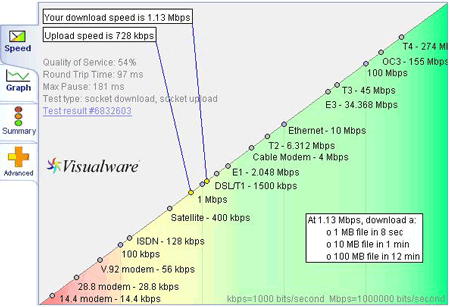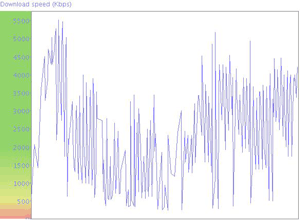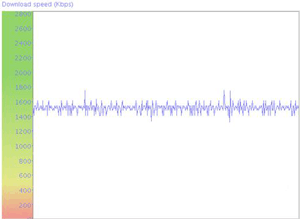|
|
MyConnection Server To The Customer, The Experience Is Everything |
| You are here: Visualware > MyConnection Server > Resources > Solving Last Mile Connection Speed Problems |
Solving Last Mile Connection Speed Problems |
|
The Resolution Process |
|
The first step in the resolution process is to perform a series of bandwidth speed tests, as a single speed test can be skewed and does not provide representative sample on which to base a complaint. To do this you should take a number of speed tests over a representative period of time at set intervals, such as every 20 minutes for a couple days. A series of tests provides a better picture of network performance and helps identify patterns, such as lower speeds during prime time or rush hour, and makes for a more credible report to provide to your ISP. It is important that you analyze the data with the purpose of identifying your assessment of the root cause. Taking this extra step does two things to help your case. Firstly it helps the remote support technician to grasp the extent of your problem more quickly, and secondly it helps you to get acceptance of the problem by the ISP. Acceptance of the problem is singularly the most important aspect of getting the problem resolved. |
|
Network Congestion Issues |
|
Proving congestion is relatively straightforward but can require collecting a good amount of speed test data. The amount of data is usually needed because network congestion, just like the rush hour traffic, occurs in cyclical time phases. Showing a clear time phase correlation is powerful proof that the ISPs network is congested.
For example the Fig. 2 graph above shows a number of speed tests extracted from the MyConnection Server Server database for a single user connection. This data shows a clear drop in service during daytime hours, which then improves towards evening and returns to normal during the night. This type of pattern is typical of congestion, and would be an issue for your ISP to address. It is also possible to get a clue that congestion is the issue before you go to the length of collecting significant amounts of data over several days. Signs of congestion can often be seen when conducting initial speed tests -- MyConnection Server analyzes the data flow during the test, the data flow graphs provide visibility to quality of your connection service.
In Fig. 3 above both tests had almost the same throughput, however the left graph shows an erratic test, a strong sign of congestion, whereas the right graph shows a test that is much more consistent, a strong sign of good quality service. Note that even in the case of a good quality test, if the actual speed was too slow it would likely mean that the throughput was limited by design, i.e. some intentional traffic control. |
|
Network Traffic Control by Design |
|
It is common to find Internet connections where traffic is regulated. Several factors drive this necessity. First it is common for users to be connected to a network which is much faster than the speed they have contracted. In other words, if you have contracted a 10 Mbps service, instead of having a dedicated 10 Mbps connection you actually have one tenth of a 100 Mbps connection. Second, there needs to be a method to adjust data flow based on data volume, not data speed. This is to prevent any single user from consuming all of the available capacity and is common on cable connections where several users share a common piece of wire. To understand traffic control issues we need to plot the traffic patterns in more detail and include the inherent delays recorded during the connection test with the speed related data. In our public road scenario, this is a bit like watching the traffic lights at a busy road junction to plot red time versus green time as it relates to the traffic volume.
In the Fig. 4 chart above we see two bandwidth measures plotted over time. The first is data (traffic) speed shown in blue and the second is data (traffic) delay shown in red. In a congestion situation the delays have no notable pattern -- there might be many small delays, a number of large delays or a mixture of both, all totally random in regards to the timing of the delays. In a traffic control environment we see the opposite, a regular pattern of delays throughout the test. This would be similar to the traffic lights on a busy road intersection, a pattern of stop/go would emerge based on the timing of the lights. Fig. 4 shows 4 red line columns indicating a 200 ms delay precisely every 2000 ms. This is hardly congestion as it is far too precise an interval to be random. This is indicative of a connection that is being intentionally policed. If you look closely at the blue data line you will see that data flow drops like a stone at the time of the delay but jumps high after the delay has passed. This is not unlike a train service such as the New York subway at 9 am on a Monday morning. If trains run frequently then, assuming passengers are arriving at a fairly constant rate, when the next train arrives the same number of passengers will board. If there is a long delay between trains then the next train to arrive after the delay will find many more passengers waiting to board and a spike in throughput will be seen. |
|
Conclusion Summary |
|
The next time you find yourself fighting network delays that you want to pass to your ISP for resolution, take a moment to gather the performance data so you can better ascertain the extent and scope of the problem you are experiencing. Just telling the ISP that your connection is slow is of little use. By taking a few extra hours or days to gather the data will better identify whether the delays are traffic congestion or traffic control related, and will help your ISP respond more quickly and resolve the issues. |
| Click here for information on how MyConnection Server can help you measure and assess your connection performance. |
|
Home |
|||





